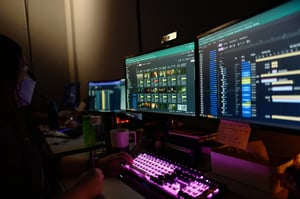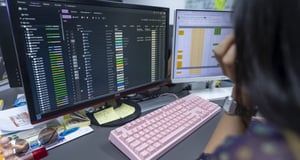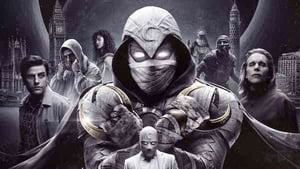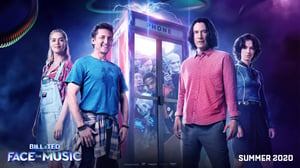
How Bill & Ted’s VFX team were excellent to each other with cineSync

Film: Bill & Ted Face the Music
Website: billandted3.com
Distributor: Orion Pictures
VFX Producer Nancy St. John takes a phone booth-shaped time machine back to the early days of video review and approval. Below, she reveals how the evolution of cineSync and its ilk have helped productions like Bill & Ted party on, even in the face of significant challenges like COVID-19.
“Be excellent to each other.” These words continue to echo down the years from what is now a 30-year-old film. The maxim’s popularity persists perhaps due to its universality. Or maybe it’s because the words have more relevance and meaning in 2020 than at any other point the last three decades. Or perhaps it’s because people really, really like Bill & Ted’s Excellent Adventure.
1989’s quirky indie script-turned unexpected box office success was and continues to be hugely popular. Bill & Ted’s Excellent Adventure spawned a sequel, numerous spin-offs and hugely influenced pop culture; even today Bill & Ted‘s 90s slacker pastiche is referenced in films, television, and beyond. Fans were over the moon when Bill and Ted themselves, Alex Winter and Keanu Reeves, announced in 2019 that production had commenced on a threequel.
In Bill & Ted Face the Music, Reeves and Winter would reprise their roles as the iconic time-travelling duo, as they sought to write a humanity-uniting song before the ultimate destruction of time and space. The concept was solid, the cast was back in action, and production was ready to kick off on the return of time travelling’s most excellent dudes.

VFX Producer, Bill & Ted Face the Music
“With cineSync keeping us connected, Bill & Ted Face the Music proved we don’t need to be together in a room to create great art.”
Only one problem stood in the way: the totally bogus onset of COVID-19. The worldwide COVID pandemic threw a major spanner in the works, threatening an end to the post-production of Bill & Ted Face the Music before the team could finalize the work. Staying focused and working together was key to the film’s successful completion. More than ever, the visual effects team needed to take a page from the characters they were creating, and be truly excellent to one another.
Below, VFX Producer Nancy St John reveals how she and her team navigated the issues of remote work and a production riddled with lockdown challenges, all with a little help from cineSync and Frankie, to enable a global visual effects team to work as one.
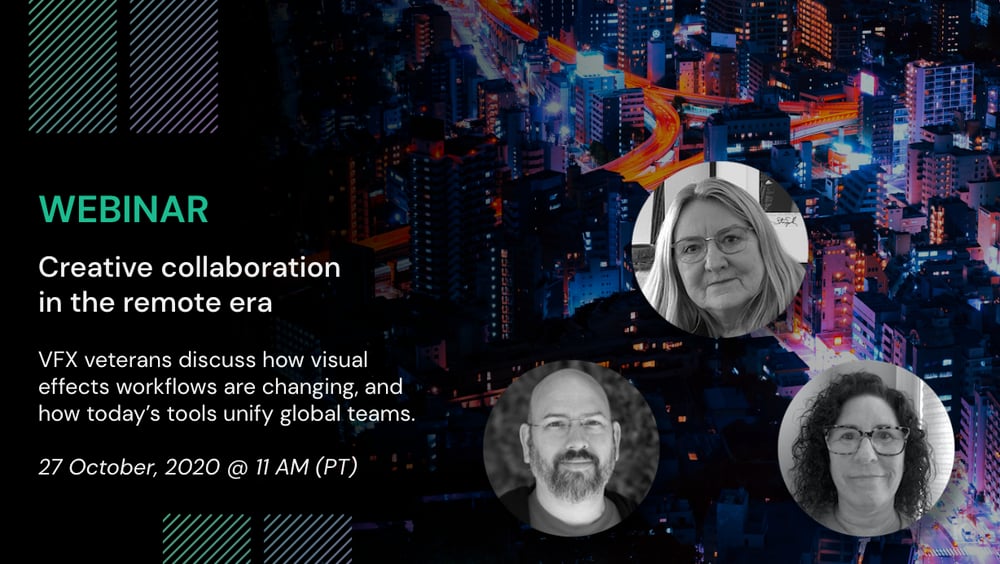 Watch Nancy discuss the challenges of remote collaboration in our webinar, Creative Collaboration in the Remote Era.
Watch Nancy discuss the challenges of remote collaboration in our webinar, Creative Collaboration in the Remote Era.
Watch the webinar
The evolution of remote work
VFX Producer Nancy St John’s credits list everything from genre-defining giants such as Ridley Scott’s Gladiator, to visual effects trailblazers like Alex Proyas’ I, Robot. Tools like cineSync and Frankie now play an essential role in her work, but she’s been in the industry long enough to remember when dailies weren’t as simple as following a link into a quick review session.
“Back in the day, everybody working in visual effects was either in or near LA,” she begins. “On the rare occasions we were forced to work remotely, we would send and receive reviews via physical tapes. The files were so large; there was no faster solution.”
cineSync and Frankie revolutionized how Nancy and her teams could approach work. “Tools like cineSync and Frankie changed everything,” she says. “I’ve used cineSync since Charlotte’s Web in 2006, and Frankie since A Series of Unfortunate Events in 2017. These tools are both such an indispensable part of our workflow now. With cineSync and Frankie, we no longer needed to be in the same room to complete work. Those products engendered a remarkable evolution that changed the way we worked.”
Flexibility was integral to the production process as filmmaking became an increasingly global industry. “Thanks to cineSync and Frankie, we can get directors and supervisors to quickly review and approve visual concepts and final shots no matter where they are in the world and without hampering the production schedule. We can also cast visual effects vendors in the same way you would typically cast an actor; selecting talent based on who will be best for the specific job required, rather than just those physically nearby.
“These processes became crucial to the ultimate completion of Bill & Ted Face the Music.”



Three vendors, three locations
The visual effects work on Bill & Ted Face the Music was awarded to three vendors: BUF and MELS Studios in Montréal, and Shade VFX in LA. Nancy managed the workflow from her home base in San Francisco, shepherding some 459 visual effects shots to the finish line, including everything from time travel to metalhead depictions of hell.
ILM VFX Supervisor, Bill George, was also brought in to oversee the work and ensure a unified vision across the three post houses and three locations.
“Working with Bill was a wonderful experience,” says Nancy. “He and Dean (Parisot, Director) founded a very special relationship back in 1999 when they worked on Galaxy Quest. The pair have a shorthand; Dean will explain a concept and Bill, being an incredible artist, would bring the ideas to life through paintings.”
Once both Dean and Bill agreed on a concept, they would use Zoom and Frankie to hold meetings and communicate the aesthetic vision to the post houses.

“Bill would act as a visual translator of Dean’s ideas and communicate them to our vendors in their different locations using Frankie. He would typically upload his painting and use Frankie’s synchronized drawing tools to make notes directly on the image. The supervisor on the vendor side could then take over drawing on the screen to add their thoughts and questions. Visual annotations meant the vendors could collaborate smoothly with Bill, even when one vendor was speaking English and the other French!”
Working via Frankie also avoided common misunderstandings from day one. “On a traditional conference call, it’s easy for everyone to come away with a different version of a visual concept, like how the overall lighting or color of a set-piece should look,” explains Nancy. “Frankie overcomes this: it’s easy to point to or even draw what we’re thinking with precision. On Bill & Ted Face the Music, we could collectively view, edit and agree on a concept in one instance. We then use cineSync to take a look at what each vendor put together at a higher resolution and progress things from there.
“Approaching work in this way made our review process effortless and kept up the momentum as we developed shots. Speed and clarity were imperative; the cineSync/Frankie combination removed any confusion and focused everyone on the art.”

Working through COVID-19
Pre-production and production on Bill & Ted Face the Music moved along smoothly enough. In post, however, something hit the project Nancy and her team could never have predicted: a worldwide pandemic.
“We had just had our first preview screening of the film, at which point Bill & Ted Face the Music was essentially a director’s cut without visual effects. They shut down LA the following day,” recalls Nancy. “That was a difficult time. We were physically scattered; nobody could even go into the office to get the things they needed.”
The team was forced to think fast, and quickly established remote workflows to ensure the largely uninterrupted production of visual effects, and a communication channel to keep everyone connected.
“Our team was on multiple Frankie’s every day,” she explains. “We’d review work both in the morning and again in the afternoon. And because Frankie works straight from our web browsers, we could collaborate from home without any technical difficulties. If you were on a Zoom call and hadn’t yet seen the referenced image, you’d get someone to send you the Frankie link and boom; you were in.”

The film’s director, producers and editorial team, as well as the VFX teams suddenly found them ourselves at home, learning new ways to work, collaborate, and contribute without physical contact. The outcomes were not at all negative, however. Nancy even discovered the benefits of her team’s remote model significantly outweighed the costs. (It may even tempt one to refer to those benefits as ‘totally bodacious’.)
“We’re in a people business, not a technology business, and I’ve always instinctively felt if you give your people a few days at home, they will create better work,” she explains.” At home, artists can concentrate. They don’t have to deal with the LA traffic. They can choose to complete sequences during the hours they feel most creative. When it comes to WFH flexibility, there are a lot of benefits.
“My experiences on Bill & Ted Face the Music and through COVID-19 proved these instincts were right: people can work just as well from home as from an office. We learned that remote work isn’t just viable but sometimes favorable: even though we completed the film amid a pandemic and a whole new level of pressure and of stress, we pulled through with this amazing result. With tools like cineSync and Frankie keeping us connected, Bill & Ted Face the Music proved we don’t all need to be together in a room to create great art.”
Try the world’s most secure review and approval
Manage creative iteration and feedback from opposite ends of the globe. See if Cinesync meets your needs with a free trial.More customer success stories


